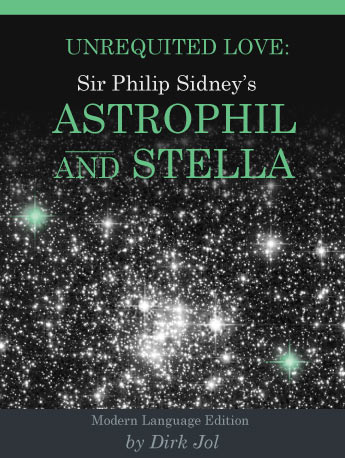Unrequited Love:
Sir Philip Sidney’s Astrophil and Stella
→ Biography of Philip Sidney


He was a frustrated young man. He had fallen in love with a young lady who was fond of him, but who was out of his reach because her family had other plans. Not only that, but she toyed with his affections, like kissing her dog while he was obliged to stand by and watch. Astrophil and Stella is the name given to the sonnet cycle that grew out of his frustrations.
Sir Philip Sidney never got to publish–or even give a title to his song and sonnet cycle–because he was killed in battle in Holland at only 31 years of age. Two unauthorized editions of his poems were published five years after his death, but were withdrawn after protests from his family, presumably because the text was riddled with errors. Nevertheless, the circulation of his poems in manuscript made the work highly influential among writers of his time. An authorized edition of the poems eventually appeared in , when it was bound in with a revised publication of his popular romance novel, The Countess of Pembroke’s Arcadia. This edition is based on the publication.
An outspoken nationalist, Sidney was keen on the development of a home-grown English literature, but Astrophil and Stella was destined to be one of his few contributions to the field. It tells the story of a courtier’s infatuation with a young lady at court and the frustrations he experiences in winning her over to his side. Enough clues are spread throughout the work to tell us that Sidney is the suitor, Astrophil (‘star-lover’), and that the object of his affections, Stella (‘star’), is none other than Penelope Devereux, the young daughter of family friends. Astrophil has an almost gravitational attraction towards Stella; Stella enjoys Astrophil’s attentions but insists that he curb his physical passion and transform it into a platonic one. Astrophil finds that he is both unwilling and unable to do so, and must reconcile himself to living outside of Stella’s orbit.
Sidney adopted and adapted the Petrarchan sonnet, revived in English translation during the reign of Henry VIII by Henry Howard and Thomas Wyatt, as his poetic model. He experimented with the form in these sonnets, using numerous different rhyme schemes and metrical patterns.
This Modern Language Edition of Astrophil and Stella is based on the publication. It will appeal to readers who have difficulties with early modern English but still want to gain a strong grasp of the contents on first reading.
Following is the sonnet sequence Astrophil and Stella as named and published by Thomas Newman in 1591, six years after Sidney's death, without family authorization. It omits Sonnet 37, which is highly critical of Penelope Devereux’s new husband. It also appends many poems that were not written by Sidney; these have been included for the sake of completeness. The original wording of Sidney’s Astrophil and Stella as published in 1591 is contained in the following downloadable PDFs:
Astrophil and Stella was republished in 1598 by William Ponsonbie. The sonnet sequence was made an attachment to Sidney’s romance novel, Urania, which was revised by his sister, Mary Herbert, the Countess of Pembroke. Readers will note that Sonnet 37 has been restored, and that the title of the work and the order of the poems have been retained from the 1591 edition. The 1598 version is contained in the following downloadable PDFs:
You may purchase an ebook (epub or mobi) of the entire 1598 version in the original wording at a nominal cost of US $1.99 by clicking on the following button:
Katherine Duncan-Jones, Sir Philip Sidney: Selected Poems, London: Oxford University Press, .
William A. Ringler, Jr., ed. The Poems of Sir Philip Sidney, London: Oxford University Press, .